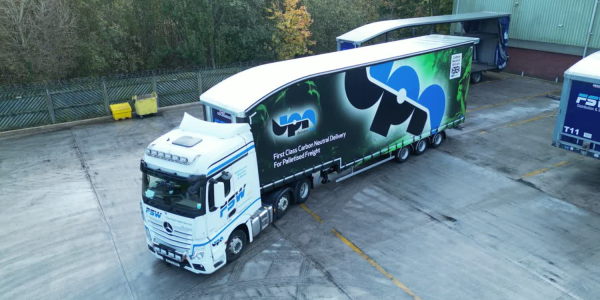Preparing for the rise and fall in demand around peak season shopping is nothing new to retailers – certainly not for pure-play ecommerce brands who are reliant on what is often a single, make-or-break, touchpoint with their consumer audience: the point of order fulfilment.
 However, despite the relative predictability of the timing of peak season, seamlessly managing its impact on ecommerce operations is far from straightforward, particularly for scale-up businesses who may find themselves at the tipping point where manual warehouse management processes are no longer able to cope.
However, despite the relative predictability of the timing of peak season, seamlessly managing its impact on ecommerce operations is far from straightforward, particularly for scale-up businesses who may find themselves at the tipping point where manual warehouse management processes are no longer able to cope.
The good news is that there are four tell-tale signs that indicate when a business is ready to embrace automation. And the even better news is that there is still time now to ready your business for peak season perfection, as Johannes Panzer, Head of Industry Solutions for Ecommerce at Descartes, explains.
Customer is King
The move from high street to ecommerce shopping has fundamentally changed consumer preferences. Priorities have dramatically shifted and companies like Amazon have set the standard for the ecommerce experience. However, while a customer’s ability to summon a single avocado to the door within 15 minutes with a single swipe of a grocery app may seem like the ultimate in personal service, in the face of increased competition, convenience is no longer enough when it comes to customer experience.
Astute retailers have started to recognise that customers today are buying into a brand experience. They are building loyalty and creating communities, based on a deep understanding of their customers’ wants, needs and values. And maintaining those values means that standards cannot slip, irrespective of operational pressures, driven by peak season demand or otherwise.
Tipping Points
For many smaller ecommerce businesses, coping with additional demand has typically meant temporarily boosting workforce numbers, a tactic that can introduce risk into what might otherwise seem like seamless operations.
As Paul Maynard, Operations Manager for scale-up fashion ecommerce brand, AYBL, says: “A tipping point came when I realised, we needed to add more labour into the warehouse. I could see a potential bottleneck with the way we were doing things. We were using paper picklists and manual processes. when scaling up it was difficult to maintain pick accuracy. We knew at that point that we needed some sort of technology like an ecommerce WMS to bring in real fulfilment automation.”
It’s a scenario many retailers are all too familiar with. Paper pick sheets get thrown around, product ID is done by eye and ‘picked’ only means ‘ticked off’. There are a mountain of issues that can build up with manual practices, which exacerbate at scale and underscore the need for automation, including:
- Orders start backing up, leading to late shipments;
- Errors start creeping into the order fulfilment process, meaning incomplete or incorrect orders;
- You start finding that you can’t fulfil some orders at all, as orders have exceeded available stock levels;
- You lose transparency of what’s happening in the warehouse, for example, what % of orders have yet to be fulfilled, or have you fulfilled all the orders with a cut-off time for air shipment, etc.
Introducing Automation
The good news is that, for retailers who have started to experience—or might anticipate—some of these issues during peak season, there is a relatively straightforward and easy-to-implement solution that maximises human collaboration and warehouse automation.
By implementing an ecommerce-optimised warehouse management system (WMS), retailers can improve picking accuracy and efficiency through mobile-based barcode scanning; introduce optimised workflows and best use of available warehouse capacity; minimise out-of-stock occurrences; can make data-driven decisions; and have clear transparency of key performance indicators on each step of the order fulfilment process. Additionally, in times of peak demand, this type of technology solution can rapidly scale to support higher order volumes and, if required, new temporary employees who can quickly become proficient with mobile scanning devices using an app that is easy to learn and provides process reliability.
AYBL’s Operations Manager, Maynard, elaborates on the early benefits of the company’s ecommerce WMS deployment: “Instantly we were able to improve picking accuracy and efficiency. We no longer needed to keep our warehouse layout in SKU order, which had been a particular challenge previously, but switched to chaotic storage. Also, the system scaled easily as we moved multiple times to larger warehouse facilities. And it has allowed us to scale up to 100+ people during peak periods, since we can train new staff within hours, which beforehand would never have been possible.” Indeed, by deploying a WMS, AYBL has doubled its fulfilment capacity with existing staff and can seamlessly scale to accurately fulfil over 70,000 orders a day during peak season.
And, despite the volume of information an ecommerce WMS handles, both in set-up and use, implementation is far from complex. With cloud-based solutions, warehouse management software can be deployed by in-house teams working with experts from the software provider without having to physically visit a site to get up and running – this is the next generation of solution deployment. If warehouse facilities are available and the vendor’s team is fully standing behind the project, an ecommerce logistics platform can be rolled out in a matter of weeks, not months.
Conclusion
Managing the rise and fall of peak season is challenging for any retailer, but for scale-up ecommerce businesses, whose reputation goes beyond just the product sale, it is imperative to recognise the early warning signs that operations have outgrown manual warehousing processes—and invest now to reap the rewards of peak season performance and to lead the way to sustainable growth.


